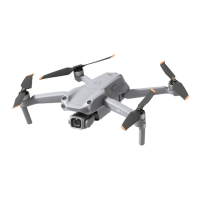DJI Air 2S User Manual
©
2021 DJI All Rights Reserved.
13
Return to Home
Return to Home (RTH) returns the aircraft to the last recorded Home Point when the positioning system
is functioning normally. There are three types of RTH: Smart RTH, Low Battery RTH, and Failsafe RTH.
The aircraft automatically flies back to the Home Point and lands when Smart RTH is initiated, the
aircraft enters Low Battery RTH, or the video link signal is lost during ight.
GNSS
Description
Home
Point
10
The default Home Point is the first location where the aircraft received a
strong to moderately strong GNSS signal where the icon is white. The Home
Point can be updated before takeo as long as the aircraft receives a strong
to moderately strong GNSS. If the GNSS signal is weak then the Home Point
cannot be updated.
Smart RTH
If the GNSS signal is sucient, Smart RTH can be used to bring the aircraft back to the Home Point.
Smart RTH is initiated either by tapping in DJI Fly or by pressing and holding the RTH button on the
remote controller until it beeps. Exit Smart RTH by tapping in DJI Fly or by pressing the RTH button
on the remote controller.
Smart RTH includes Straight Line RTH and Power Saving RTH.
Straight Line RTH Procedure:
1. The Home Point is recorded.
2. Smart RTH is triggered.
3. a. If the aircraft is farther than 50 m from the Home Point when the RTH procedure begins, the aircraft
adjusts its orientation and ascends to the preset RTH altitude and ies to the Home Point. If the
current altitude is higher than the RTH altitude, the aircraft ies to the Home Point at the current
altitude.
b. If the aircraft is at a distance of 5 to 50 m from the Home Point when the RTH procedure begins,
the aircraft adjusts its orientation and ies to the Home Point at the current altitude.
c. If the aircraft is less than 5 m from the Home Point when the RTH procedure begins, it lands
immediately.
4. After reaching the Home Point, the aircraft lands and the motors stop.
If the RTH is triggered through DJI Fly and the aircraft is farther than 5 m from the Home Point, a
prompt will appear in the app for users to select a landing option.
Power Saving RTH Procedure:
During Straight Line RTH, if the distance is farther than 480 m and the altitude is more than 90 m above
the RTH altitude as well as more than 290 m above the takeo altitude, a prompt appears in DJI Fly
asking the user if they wish to enter Power Saving RTH. After entering Power Saving RTH, the aircraft
adjusts to an angle of 14° and ies to the Home Point. The aircraft lands when it is above the Home
Point and the motors stop.
The aircraft exits from power saving RTH and enter Straight Line RTH in the following scenarios:

